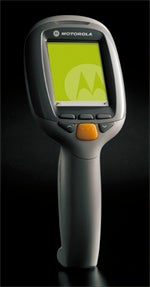Motorola Either way, Motorola’s latest foray into enterprise technology products is in full swing with the third-generation release of its MC17 mobile computer device for retailers. Call it an unfettered kiosk designed to get shoppers to pick it up, play with it, and, most importantly, receive personalized marketing messages. If that approach helps drive more sales, then those happy retailers are also happy customers of Motorola. The MC17 symbolizes another extension of the self-service stations that are growing more popular at retail outlets such as grocery stores and pharmacies, said Chris Ciervo, a product manager for Motorola. Unlike stationary scanners in retail stores these days, this device is a handheld kiosk that does more than provide look-up information in the store. It also sends affinity information to participating customers when they swipe their shopping card next to the scanner. “What we’re seeing today is a little more of this emphasis” in new store layouts, he told internetnews.com. “It can be in a rack when customers walk into the store. Then, they can pick them up, scan their loyalty information, then start their shopping process. It’s also available to do things like stock lookup, inventory and to help with line-busting,” a term used by retailers to help break up long lines at traditional checkouts in stores. In a sense, the self-service checkout functionality more shoppers experience has now moved into the store aisles, Ciervo noted. “It’s actually doing all that scanning while they shop. The value to the retailers is that, instead of when they check out, they have a point of activity to push various forms of content down to the consumer as they’re putting items in their baskets. Those are the cross-selling opportunities. So there are potentially greater opportunities for a larger basket size.” The target markets for the product include retail environments such as mass merchandisers, grocery department stores and pharmacies. The twist on this launch are the contextual suggestions the device collects and pumps out (assuming the person is participating in an affinity program) when the shopper is actually traipsing the aisles. In addition, the MC17 can be used for gift registry in department and specialty stores. The release is an important one for Schaumburg, Ill.-based Motorola. The world’s No. 2 wireless device maker has made enterprise mobile sales a key piece of its strategy. Since its purchase of wireless handset maker Symbol Technologies for $3.9 billion last September, Motorola is positioned to scoop up market share in the sector even as it weathers price pressure on its consumer phone lines. Symbol’s main business is with enterprises, especially with scanning devices for retailers and point-of-sale spots at checkout lines. (The MC 17 is a Symbol-developed technology.) Motorola, on the other hand, commanded about a 5 percent share of the enterprise market in this sector before purchasing Symbol, according to Gartner Research. It’s not Motorola’s only move to gain market share with businesses. Last November, it snapped up privately-held Good Technology in order to spice up mobile applications for business users, most notably for its Q smartphone. The MC17 deploys the Windows CE 5.0 operating system and uses the PocketBrowser from Motorola to enable developers to build mobile applications for enterprises, such as printing and bar code scanning. And, of course, it’s compatible with prior Symbol systems too. So is Motorola concerned that some customers might walk off with the devices? Not at all. Motorola’s Seldon Safir, a director of product marketing for the company’s enterprise mobility division, said the device would emit beeps to let the store know it has left the building. Then again, RFID calls it the next generation retail solution with enterprise mobility technology. But the company just wants shoppers to call its latest wireless device a cool thing, and use it.
The handheld ‘cool thing.’
Source: Motorola



